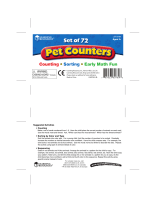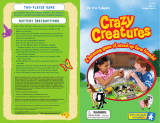Page is loading ...

LER 0180
3
+
PreK
+
Animales de la granja clasificación
Objets de tri - animaux de la ferme
Bauernhof Tierfiguren
Ages • Años
Ans • Jahre
Classer
—incitez les enfants à classer les figures en différents groupes
en fonction de leurs attributs, de leur forme, couleur, taille, etc.
Regrouper
—créez des familles à l’aide des figures. Les enfants sont-
ils capables de continuer la famille que vous avez commencée ? Les
enfants peuvent-ils créer leur propre famille ?
Inventer des problèmes
—servez-vous des figures pour créer
et résoudre des problèmes comportant des additions et des
soustractions. Réalisez cette activité avec de nombreuses quantités,
figures, et scénarios différents.
Aktivitäten:
Freie Erforschung
− Geben Sie den Kindern die Möglichkeit, die
Figuren zu erforschen. Den Kindern Zeit zur freien Erkundung zu
geben, ermöglicht es ihnen, alles selbst zu tun, zu sehen, zu fühlen,
zu berühren, zu erfinden und zu entdecken.
Was fehlt?
− Stellen Sie mehrere Figuren vor ein Kind. Das Kind
sollte sie untersuchen und dann beide Augen schließen, während Sie
eine der Figuren entfernen. Sehen Sie, ob Ihnen das Kind sagen kann,
welche Figur fehlt.
Sortieren
− Lassen Sie die Kinder die Figuren nach Kriterien in
verschiedene Sätze aufteilen, wie z. B. nach Form, Farbe, Größe usw.
Nachbilden
− Erstellen Sie Muster mit den Figuren. Können die
Kinder das von Ihnen angefangene Muster weiterführen? Können die
Kinder selbst ein Muster erstellen?
Textaufgaben
− Verwenden Sie die Figuren, um Textaufgaben, die
das Addieren und Subtrahieren beinhalten, zu erstellen und zu lösen.
Führen Sie diese Aktivität mit vielen verschiedenen Mengen, Figuren
und Szenarien durch.
Your opinion matters! Visit
www.LearningResources.com
to write a product review or to
find a store near you.
Like
us on
© Learning Resources, Inc., Vernon Hills, IL, US
Learning Resources Ltd., Bergen Way,
King’s Lynn, Norfolk, PE30 2JG, UK
Please retain our address for future reference.
Made in China. LPK0180-GUD
Hecho en China. Conservar estos datos.
Fabriqué en Chine. Informations à conserver.
Hergestellt in China. Bitte bewahren Sie unsere
Adresse für spätere
Nachfragen auf.
2 Sizes • tamaños • tailles • Größen
6 Colors • colores • couleurs • Farben
6 Shapes • figuras • formes • Formen
S
e
t
d
e
•
J
e
u
d
e
•
S
e
t
m
i
t
72
Set of
Animales de la granja clasificación
Animal Counters
Animales de la granja clasificación
Objets de tri - animaux de la ferme
Animales de la granja clasificación
s
DE

Barnyard Buddies
Friendly Farm
®
Animals can be sorted many ways—by animal,
color, and even size. Start out by having children sort the
counters into their six species: pig, horse, cow, rabbit, duck, and
sheep. For young children, start with just a few of each set so
that the task isn’t too big. Next, ask children to sort the animals
by color.
Once children have mastered species and colors, have them sort
the animals by size. Show the children that each large animal
has a matching small animal. Use words like pair to discuss
matching large and small animals.
Tell Me a Story
Children will naturally use Friendly Farm Animals for
imaginative play. Encourage this kind of play, and use it as
a language enrichment activity. Ask children to tell stories
with the animal counters. Have them describe the sounds the
different animals make. Talk about a trip to the farm, and what
children could see there. Ask what they would like to do if they
lived on a farm, and also what they would not like to do.
Friendly Farm Number Stories
Friendly Farm Animals are perfect for early story problems. For
example: “Four cows were standing outside near a barn. Two
cows went inside to be milked. How many were left outside?”
By the Handful
Ask children, “How many large animals do you think you can
hold in one hand?” Record the answer. Then, see how many
animals they can actually hold in one hand. Compare the
numbers. Use the words more and fewer. Repeat this game
using two hands. Repeat using the small animals. Are the
results different?
Touch and Name Game
Put several animals into an opaque bag, such as a small paper
lunch sack. Have children reach into the bag and determine
which animals are there just by feeling, not looking. Add more
animals to the bag as children become familiar with the game.
Counting My Animals
You will need a numeral die for this game. Put a pile of animals
in the center of a playing area. Two or more players take
turns rolling the numeral die and selecting the corresponding
number of animals from the center. The winner is the player
with the most animals when all the animals have been chosen.
Actividades:
Exploración libre
—Da la oportunidad a que los niños exploren las
figuras. Dale tiempo a los niños para explorar con libertad. Déjeles
crear, ver, sentir, tocar, inventar y descubrirlo todo por su cuenta.
¿Qué falta?
—Coloque varias figuras frente al niño. Deje que el niño
las estudie, y que después cierre los ojos mientras retira una de las
figuras. El niño debe adivinar qué figura es la que falta.
Clasificación
—Haga que los niños clasifiquen a las figuras según
distintas características: color, forma, tamaño, etc.
Serie
—Cree una serie con las figuras. ¿Los niños pueden continuar la
serie que hizo? ¿Los niños pueden hacer series por ellos mismos?
Problemas matemáticos
—Utilice las figuras para crear y resolver
problemas matemáticos que incluyan sumas y restas. Realice esta
actividad con diversas cantidades, figuras y problemas.
Activités :
Exploration libre
—donnez l’opportunité aux enfants de partir en
exploration avec les petits comptables. En donnant du temps aux
enfants pour explorer librement, vous leur permettez de faire, de
voir, de sentir, d’inventer et de découvrir par eux-mêmes.
Qu’est-ce qui manque ?
—Placez plusieurs figures devant un enfant.
L’enfant doit les observer puis fermer les yeux, tandis que vous
retirez l’une des figures. Regardez si l’enfant est capable de vous dire
quelle pièce manque.
ES
FR
/







